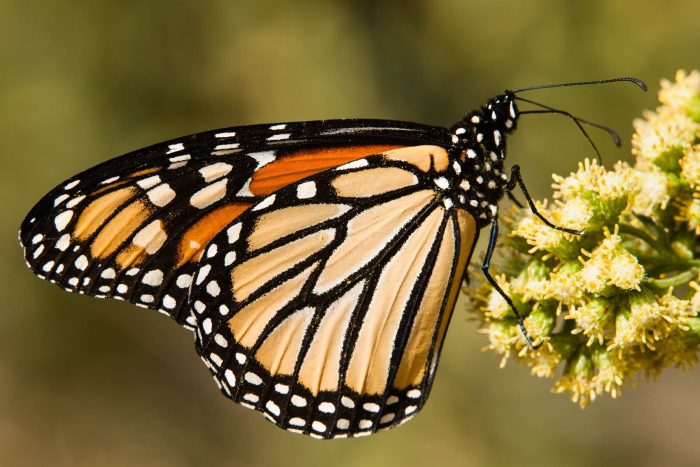Monarch Butterfly
Danaus plexippus
The monarch butterfly is known for its bright orange and black wings, which signal to potential predators that the species is poisonous.
This section shows one large critter image at a time. Use the thumbnails that follow to select a specific image to display here.

This gallery contains a grid of small thumbnails. Selecting a thumbnail will change the main image in the preceding section.
Appearance
Adult monarch butterflies have wingspan of about four inches. Their bright orange upperwings are interlaced with black veins and surrounded by a wide, black border marked with white spots.
The undersurface of their wings are colored a duller orange to camouflage the species against tree bark. Males are slightly larger than females, and they have a black spot on each hind wing. Monarch caterpillars have black, white and yellow bands over body with a pair of long black filaments near head and a pair of shorter filaments near rear.
Feeding
Monarch caterpillars feed on milkweed plants, while adults forage for flower nectar.
Predators
The bright coloring of adults warns potential predators the species is poisonous, thanks to the accumulation in their bodies of toxic chemicals produced by milkweed plants. However, caterpillars are preyed upon by some invertebrates, like wasps and ants.
Reproduction and life cycle
Monarch mating occurs throughout summer and once again in spring, before adult butterflies migrate from their overwintering sites. During courtship, the male pursues and nudges the female in the air before taking her down to the ground to mate. Females lay small eggs on milkweed "host plants," often on the underside of leaves.
Once hatched, caterpillar eats almost constantly over a nine-day to two-week period, shedding its skin several times before forming a chrysalis around itself and transforming from into a butterfly. The lime-green chrysalis is marked with gold spots and a black, horizontal band edged with gold. Most monarch butterflies live for 5 weeks, except for the generation born at the end of summer. These butterflies will live up to 8 months as they fly back to their wintering grounds in Central and South America, where they stay until the following spring.
Did you know?
- A single monarch butterfly can migrate thousands of miles. They are the only species of butterfly to make such a massive journey.
- Monarchs overwinter in the branches and trunks of trees. Sometimes a branch will get so heavy with wintering monarchs that it breaks off and falls to the ground.
Sources and additional information
- Danaus plexippus – University of Michigan Museum of Zoology
- Monarch butterfly – Danaus plexippus – NatureWorks
